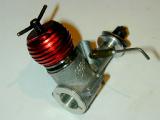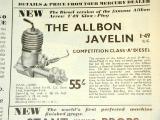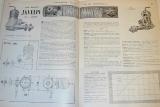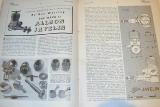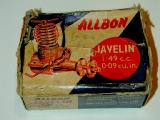| Name | Javelin | Designer | Alan Allbon |
| Bore | .525" | Stroke | .420" |
| Type | Compression Ignition | Capacity | 1.49cc |
| Production run | Lots | Country of Origin | England |
| Photo by | Ron C | Year of manufacture | 1950-1953 |
Background
In 1949, Allbon Engineering released their comparatively short-lived 1.49cc Allbon Arrow glow motor. This was followed a couple of months later by the more successful Allbon Javelin, a diesel of the same capacity that utilized the same crankcase. Over the next three years, the range grew with first the 1cc Allbon Spitfire, then the 0.5cc Dart. Judged by the number of plans appearing in Aeromodeller showing one or the other of the engines, the range was well received, with the Dart being especially suited to small free flight scale designs popular at the time (and much sought after for the same purpose today). In 1953, Allbon Engineering merged with Davies Charlton and production moved to the Isle of Mann as already chronicled in the Manxman story. Both Javelin and Dart went through one major design change in late 1952. The revised engines were called "Mk2" although the exterior changes were small. The Javelin Mk2 was, I believe, the inspiration for a number of other engines from other designers in the UK and abroad. Today the engine is comparatively rare, probably due to its very light construction which must have seen literally thousands consigned to the tip due to damage and wear. My example, seen here, is a rare New-In-Box Mk2, circa mid 50's probably (no Allbon's carry serial numbers), and so, alas, too damn valuable to run (grrrr).
The first advertisement for the Javelin appeared nested in the Mercury Models full page add in the front section of Aeromodeller for February 1950. Earlier advertisements for the Arrow had been placed by Allbon Engineering, mentioning Mercury as the "sole distributor" (the Arrow was praised with feint damns by our friend, Lawerence H Sparey, in the January 1950 Aeromodeller). The Javelin quickly disappeared from Mercury's advertising as they concentrated on their growing kit range, so Allbon once again started placing small adds for the Javelin in the rear of Aeromodeller, though Mercury Models was still identified as their sole distributer. The blue headed Arrow was mentioned as still being available in these adds at the same price, fifty-five shillings, though it silently disappeared in 1951.
Distribution must have been a tribulation for Allbon. In August 1952, the Allbon add nominated DC Ltd (Davies-Charlton) as the exclusive distributor. The next month, this changed to E. Keil and Co (Keil Kraft). This lasted through the merger with DC Ltd, and for a time, KK was distributor for DC. Using the evidence of their adds, in June 1953 DC took over distribution themselves. After than, I'm afraid I got tired of following the twisty little maze.
The first add that specifies DC as the "manufacturer" of the "Davies Charlton—Allbon range" appeared in Aeromodeller of February 1953. This add showed the Mk II versions of the Dart and Javelin, together with DC diesel and glow versions of their 350 (later to be redesigned as the Manxman). Note that E Keil is still nominated as the "sole distributor", the price has risen, and the dreaded purchase tax has been added. The ad appeared on the front inside cover of Aeromodeller—a location DC held in that magazine almost until their demise in the 1980's—apart from the December issues where the space was usually reclaimed by Aeromodeller to promote the Annual for the year.
Aeromodeller reviewed the Javelin three times. The first test was conducted in July 1950 by Sparey. He found it to be a light, easy starting, powerful engine, delivering peak BHP of 0.10 at 12,000 RPM. The Mk1 is externally descernable from the Mk2 pictured above by the L-shaped "bent-over" compression screw and plain-faced prop driver. Internally, the engine featured rather unconventional piston construction. The gudgeon pin (wrist pin to US readers) was carried in a dural turning that fitted inside a light, "Meehanite" cast-iron closed sleeve. The top sides of the outer piston were conical to assist transfer, with the assembly being optimistically held together by a slotted countersunk screw in the center of the crown, truncating the cone shape. The prime reason for this arrangement would seem to be the three generously dimensioned internal transfer flutes arranged between the three peripheral exhaust ports. By fully enclosing the pin, there was no danger of it jamming the engine up solid with attendant disastrous results. A feature I whole heartedly approve of on both Marks is the flats for a spanner milled on the top fin of the cooling jacket. Although it requires an extra operation (and probably set-up), it affords some protection from the dreaded multy-grip treatment that so many Taipans of similar configuration have suffered under the urgency of field maintenance.
With the release of the Mk2, Aeromodeller re-tested the Javelin in the January 1953 issue. By this time, engine testing had been taken over by Ron Warring with the Javelin being "No. 6 of the New Series". The Warring review ran to three pages and went into detail on the changes, internal and external. The tommy-bar was now "T" shaped (or more correctly, "V" shaped) and the prop driver had been spiral knurled in the direction guaranteed to assist prop-throwing under back-fire conditions (my observation—RW made no comment). Internally, the cylinder design had been revised to place the transfer flutes on the outside, with angled holes emerging between the exhaust ports. This permitted the gudgeon pin and piston—now flat topped—to be more conventional and easier to manufacture. Warring also noted, in delightful British understatement, that this arrangement would no longer be prone to have the screw work loose, thus producing "startling noises". In the test results, the power curves now showed the engine peaking at 11,000 RPM and 0.12 BHP.
At 2.25 oz, the Javelin is certainly a light weight engine for its capacity—lighter even than the smaller 1cc Allbon Spitfire. The case is a very fine die casting with no more than the minimum amount of metal required to hold the moving bits in place. The "Allbon" name and "Made in England" are delicately reproduced in raised lettering. There are no discernable differences between the Mk1 and Mk2 cases (besides, die changes are expensive!) The fact that the shaft runs un-bushed in the case contributes to this lightness, although I'd not want see one rammed into the hard, dry, baked, unforgiving school yards we flew control line over down here in the 50's. Possibly the soggy fields and meadows of Olde England were more forgiving—though Ron Warring does warn about what a little dirt following a prang will do to the soft shaft bearing.
Comparison of the revised graphs (top) with those produced two years earlier show that peak power of 0.121 BHP had been measured at about 11,400 RPM, although the test still states the peak was at 11,000. The Torque curve, while lower, had a more normal peak in the vicinity of 9,000 RPM rather than the steady decline from the get-go shown in the 1953 test results. Referring to the prop vs RPM table published earlier, the torque peak would be realized on an 8x4 to 8x5 prop, making the engine ideal for larger free flight models. Unaccountably, the engine weight is now quoted as 3 oz.
My example, won in a frenzy of Internet bidding on eBay, came complete with box and papers, even if the former is a little tattered, and the latter almost transparent with oil absorption. As seen here, the box featured a "pop-up" fold feature for display cases popular at the time. Inside is a folded card insert, punched out to the Javelin shape as packaging support. The price written on the outside probably reflects the selling price in Australia pre-decimal currency; considerably higher than that shown in the UK adds.
Inside the box we find the instruction leaflet, a short length of now very hard plastic fuel line, and a packet that had contained the needle valve. The latter being rather unattractively soldered into the brass thimble (see rear aspect shot above). As this is a new, un-run engine, the crude job is obviously factory original, the only black mark on an otherwise delightful little engine (maybe I could give it just one little run, who's to know?  )
)
![]()

